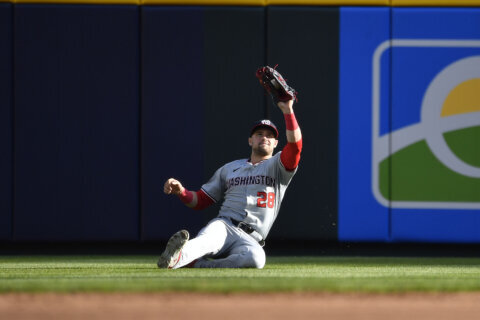I was recently speaking to a friend about a high school girls basketball playoff game in a neighboring jurisdiction. With a four-point lead and still a quarter to play, the home team went into full-blown stall ball. Think Dean Smith’s legendary four corners. They literally took the air out of the ball.
The next day, an Ohio boys basketball playoff game had a halftime score of 6-4 — not because the teams couldn’t shoot straight, but because one coach thought his team had a better chance to win by holding the ball and making the game shorter.
I don’t know if any ticket-buying fans asked for refunds from that snoozer. The stallers lost 24-12.
But I believe this: The game would be better served — coaches, players, fans and all — if the National Federation of State High School Associations mandated that high school basketball be played with a shot clock, eliminating these instances where teams just hold the ball for minutes on end.
At present, there are eight states that mandate shot clock use. In the DMV, we are fortunate that the District of Columbia and Maryland require their teams play with a 30-second shot clock. (The Virginia High School League does not mandate a shot clock and a spokesman earlier this year said there have not been substantive talks about adding one.)
Speaking on behalf of the D.C. State Athletic Association, we moved to a shot clock for our state tournament in 2015. Our players grow up watching NBA and college games on TV and many play in AAU leagues with shot clocks during the offseason. Players today grow up learning the game with a shot clock. The shot clock modernizes the game and brings high school basketball into the 21st century. In 2018, USA Basketball and the NBA announced recommendations for young athletes that included a 24-second shot clock in high school and a 30-second shot clock for ages 12 to 14.
I would compare using a shot clock to the adoption of a universal three-point line in college basketball and then high school basketball. Going back even further, some might remember when girls basketball was played 6-on-6, as two different games of 3-on-3 basketball, and “purists” thought that going to 5-on-5 would ruin the sport. Nothing could be further from the case.
Change is difficult. We all know that. But sometimes change is necessary to continue moving forward.
The debate over whether the NFHS should mandate shot clocks nationwide has grown louder in recent years, with repeated attempts to pass legislation. The discourse inevitably heats up during high school playoffs in late February and early March.
Those who favor the status quo often say that it will affect the integrity of the game or bring up what they believe is an excessive cost to outfit all gyms with shot clocks. They might say there is an additional cost to have a trained adult work the shot clock. Or they might say that only 6% of all high school athletes will go on to play in college, so why are we catering to that six percent?
In our area, I know that so many players want to go on to the next level, where the shot clock is part of the game. I might be biased, but we have some of the best high school basketball players in the country right here in the DMV and the shot clock has not been a detriment to the game.
We get our fair share of criticism about a variety of things, but using a shot clock is one thing no coach or administrator has every complained about. It’s time for the rest of the country to join the 21st century too.
Clark Ray has served as the Executive Director of the District of Columbia State Athletic Association since its inception in 2012. Clark is a graduate of the University of Arkansas and received a master’s degree in education from Temple University. He lives in Washington with his husband and their two sons.







